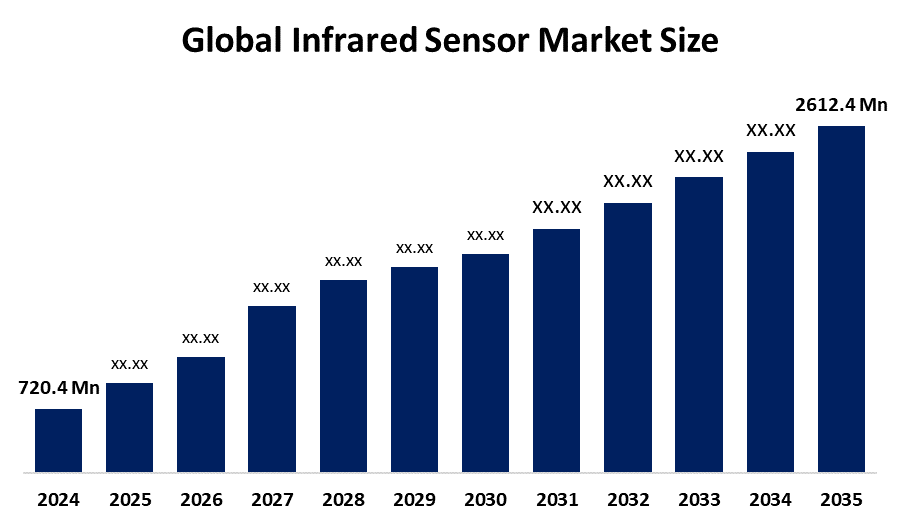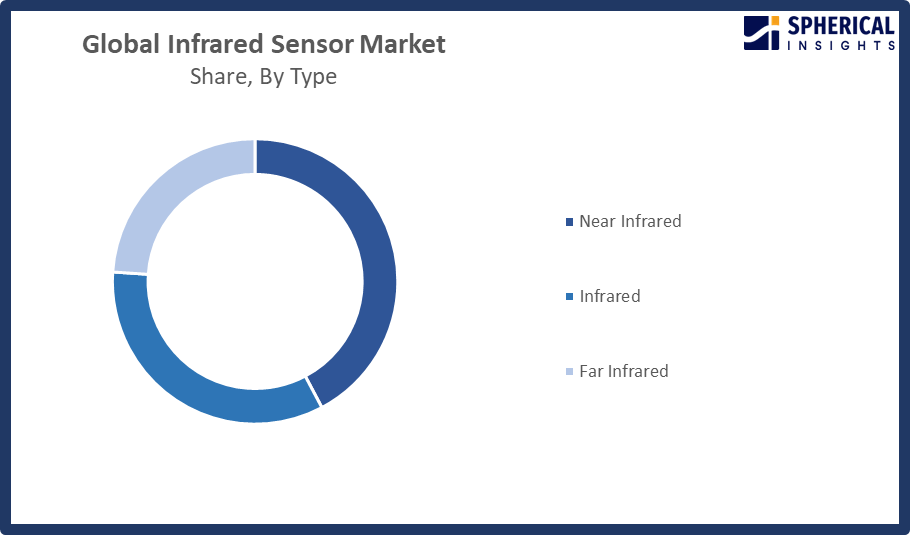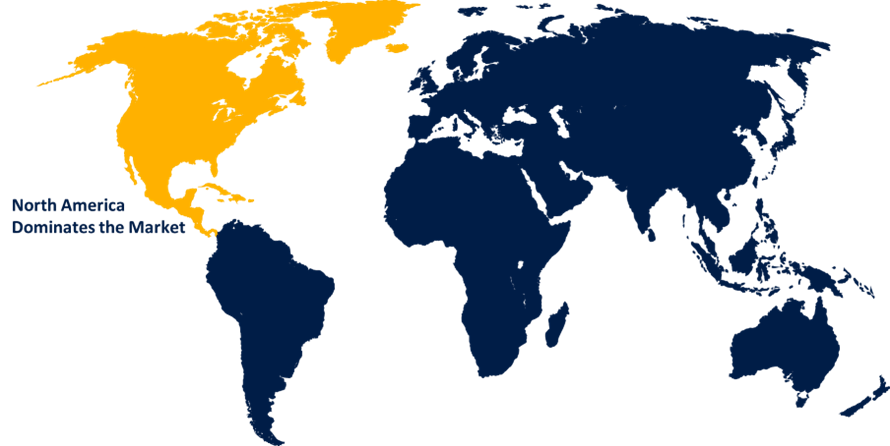Global Infrared Sensor Market Size, Share, and COVID-19 Impact Analysis, By Type (Near Infrared, Infrared, and Far Infrared), By Application (Motion Sensing, Temperature Measurement, Security & Surveillance, Gas & Fire Detection, Spectroscopy, and Others), and By Region (North America, Europe, Asia-Pacific, Latin America, Middle East, and Africa), Analysis and Forecast 2025 - 2035
Industry: Semiconductors & ElectronicsGlobal Infrared Sensor Market Size Insights Forecasts to 2035
- The Global Infrared Sensor Market Size Was Estimated at USD 720.4 Million in 2024
- The Market Size is Expected to Grow at a CAGR of around 12.42% from 2025 to 2035
- The Worldwide Infrared Sensor Market Size is Expected to Reach USD 2612.4 Million by 2035
- Asia Pacific is expected to grow the fastest during the forecast period.

Get more details on this report -
According to a Research Report Published by Spherical Insights and Consulting, The Global Infrared Sensor Market Size was worth around USD 720.4 Million in 2024 and is predicted to Grow to around USD 2612.4 Million by 2035 with a compound annual growth rate (CAGR) of 12.42% from 2025 to 2035. Increased industry demand for automation, growing consumer electronics use, improved security systems, and developments in autonomous cars are all contributing factors to the growth of the global infrared sensor market. Further driving market growth and technological innovation are expanding applications in the healthcare and military sectors.
Market Overview
The global infrared sensor market refers to industry focused on devices that detect infrared radiation for applications in automation, security, consumer electronics, healthcare, and industrial monitoring systems. Growing acceptance in the consumer electronics, automotive, and healthcare industries is propelling the worldwide infrared sensor market's notable expansion. Infrared sensors are essential for consumer electronics capabilities like gesture recognition, ambient light adjustment, and proximity sensing in smartphones, tablets, and smart home appliances. Demand is further increased by the expanding usage of AR and VR technologies, which improve user interactivity and energy efficiency. In the automotive sector, infrared sensors are essential to advanced driver assistance systems, which enhance vehicle automation and safety by offering night vision, pedestrian detection, and adaptive cruise control. The popularity of autonomous and electric cars is accelerating their uptake. In healthcare, infrared sensors are used for non-contact temperature measurement, vital sign monitoring, and medical imaging, supporting remote patient monitoring and telehealth. They also assist in fever screening and diagnosing circulatory or musculoskeletal disorders. Integration into wearable devices is advancing personalized healthcare and preventive diagnostics. Overall, increasing automation, safety awareness, and technological innovation continue to propel the infrared sensor market’s expansion globally.
Teledyne Technologies Incorporated provides advanced technologies for industrial markets requiring innovation and reliability. Its diverse portfolio includes aircraft information management systems, digital imaging sensors, marine and environmental monitoring instruments, and cameras operating across visible, infrared, and X-ray spectra. The company also offers electronic test equipment, rugged interconnects, defense electronics, and satellite communication subsystems. Teledyne’s operations are mainly based in the United States, Canada, the United Kingdom, and Western and Northern Europe.
Report Coverage
This research report categorizes the infrared sensor market based on various segments and regions, forecasts revenue growth, and analyzes trends in each submarket. The report analyses the key growth drivers, opportunities, and challenges influencing the infrared sensor market. Recent market developments and competitive strategies such as expansion, type launch, development, partnership, merger, and acquisition, have been included to draw the competitive landscape in the market. The report strategically identifies and profiles the key market players and analyses their core competencies in each sub-segment of the infrared sensor market.
Global Infrared Sensor Market Report Coverage
| Report Coverage | Details |
|---|---|
| Base Year: | 2024 |
| Market Size in 2024: | USD 720.4 Million |
| Forecast Period: | 2025-2035 |
| Forecast Period CAGR 2025-2035 : | 12.42% |
| 2035 Value Projection: | USD 2612.4 Million |
| Historical Data for: | 2020-2023 |
| No. of Pages: | 164 |
| Tables, Charts & Figures: | 143 |
| Segments covered: | By Type, By Application and COVID-19 Impact Analysis |
| Companies covered:: | FLIR Systems, Inc., Hamamatsu Photonics K.K., Murata Manufacturing Co., Ltd., Texas Instruments Incorporated, Raytheon Technologies Corporation, Honeywell International Inc., NXP Semiconductors N.V., Teledyne Technologies Incorporated, Excelitas Technologies Corp., Lynred, Omron Automation, Vishay Intertechnology, Inc., and Others |
| Pitfalls & Challenges: | COVID-19 Impact, Challenges, Future, Growth, & Analysis |
Get more details on this report -
Driving Factors
The expansion of automotive safety systems like ADAS and night vision, the growing demand for automation and smart technologies across industries, and the growing adoption of features like gesture recognition and proximity sensing in consumer electronics are the main factors propelling the global infrared sensor market. Additionally, growing healthcare applications for remote monitoring and non-contact temperature measurement, together with developments in industrial automation, defence, and surveillance, are driving market expansion. Market expansion is further supported by energy-efficient designs and technological innovation.
Restraining Factors
High production and installation costs, which restrict adoption in cost-sensitive applications, are impeding the growth of the global infrared sensor market. Accuracy can also be impacted by performance problems such signal interference, low detecting range, and sensitivity to environmental factors. Lack of standardization and worries about data privacy can impede market growth.
Market Segmentation
The Infrared Sensor market share is classified into type and application.
- The near infrared segment dominated the market in 2024, approximately 42.6% and is projected to grow at a substantial CAGR during the forecast period.
Based on the type, the infrared sensor market is divided into near infrared, infrared, and far infrared. Among these, the near infrared segment dominated the market in 2024 and is projected to grow at a substantial CAGR during the forecast period. It is widely used in industries including environmental monitoring, medical diagnostics, and telecommunications. In the healthcare industry, NIR sensors are frequently utilised for non-invasive medical imaging methods like spectroscopy and pulse oximetry. Their market domination has been further reinforced by their application in fibre optic communications and manufacturing quality control procedures. NIR Working Mechanism has a significant market share because of its cost-effectiveness and versatility, which have made it a popular option for a variety of commercial and industrial applications.

Get more details on this report -
- The motion sensing segment accounted for the highest revenue market share in 2024, approximately 28.5% and is anticipated to grow at a significant CAGR during the forecast period.
Based on the application, the infrared sensor market is divided into motion sensing, temperature measurement, security & surveillance, gas & fire detection, spectroscopy, and others. Among these, the motion sensing segment accounted for the largest share in 2024 and is anticipated to grow at a significant CAGR during the forecast period. Motion sensors are crucial for both home and business security because they can identify movement and initiate actions like lights, alarms, and automated home controls. The need for motion-sensing infrared sensors has been greatly increased by the spread of smart home appliances and the growing emphasis on energy savings and safety. Additionally, the incorporation of these sensors into a variety of products, such as smartphones and game consoles, has strengthened their market domination.
Regional Segment Analysis of the Infrared Sensor Market
- North America (U.S., Canada, Mexico)
- Europe (Germany, France, U.K., Italy, Spain, Rest of Europe)
- Asia-Pacific (China, Japan, India, Rest of APAC)
- South America (Brazil and the Rest of South America)
- The Middle East and Africa (UAE, South Africa, Rest of MEA)
North America is anticipated to hold the largest share with approximately 38% of the Infrared Sensor market over the predicted timeframe.

Get more details on this report -
North America is anticipated to hold the largest share of the infrared sensor market over the predicted timeframe. Driven mostly by strong technology developments and widespread industry adoption rates. Strong R&D skills, significant investments in the defence and aerospace industries, and an established industrial foundation all benefit the region. North America's leading position in the global market is also influenced by strict regulations and growing applications in smart gadgets, healthcare, and automobile safety systems. The United States has made large expenditures in the consumer electronics, aerospace, and defence sectors, all of which are major consumers of infrared sensor technologies. The nation's sophisticated healthcare system and strict regulatory framework also encourage the use of infrared sensors in safety systems and medical applications.
Asia Pacific is expected to grow the fastest market share with approximately 13.2% at a rapid CAGR in the infrared sensor market during the forecast period. The need for infrared sensors in manufacturing automation and process control applications is driven by the fast industrialization of rising economies like China and India. The growing automobile industry in the area also makes a substantial contribution, as infrared sensors for ADAS and safety systems are increasingly incorporated into cars. Additionally, growing expenditures in consumer electronics and smart infrastructure boost the Asia Pacific's strong market growth trajectory by increasing demand for infrared sensors.
Europe is expected to grow at a rapid CAGR in the infrared sensor market during the forecast period. These industries significantly increase the need for infrared sensors for a variety of uses, including thermal imaging, medical diagnostics, and car safety systems. Furthermore, infrared sensor usage in building automation and temperature monitoring applications is further boosted by Europe's emphasis on environmental legislation and energy efficiency standards, which contributes to the region's market significance.
Competitive Analysis:
The report offers the appropriate analysis of the key organizations/companies involved within the infrared sensor market, along with a comparative evaluation primarily based on their type of offering, business overviews, geographic presence, enterprise strategies, segment market share, and SWOT analysis. The report also provides an elaborative analysis focusing on the current news and developments of the companies, which includes type development, innovations, joint ventures, partnerships, mergers & acquisitions, strategic alliances, and others. This allows for the evaluation of the overall competition within the market.
List of Key Companies
- FLIR Systems, Inc.
- Hamamatsu Photonics K.K.
- Murata Manufacturing Co., Ltd.
- Texas Instruments Incorporated
- Raytheon Technologies Corporation
- Honeywell International Inc.
- NXP Semiconductors N.V.
- Teledyne Technologies Incorporated
- Excelitas Technologies Corp.
- Lynred
- Omron Automation
- Vishay Intertechnology, Inc.
- Others
Key Target Audience
- Market Players
- Investors
- End-users
- Government Authorities
- Consulting and Research Firm
- Venture capitalists
- Value-Added Resellers (VARs)
Recent Development
- In April 2024, the radiometric version of its long-wave infrared small camera platform, known as MicroCalibir, was introduced by Teledyne DALSA, a Teledyne Technologies Incorporated company that specialises in machine vision technologies. The platform is perfect for a variety of applications in industrial process monitoring and maintenance, security and surveillance, and search and rescue since it provides accurate temperature measurements of +/-2°C or +/-2%.
- In October 2023, Industry automation solutions supplier Omron Automation announced the introduction of its SWIR camera series, which uses special short-wave infrared technology to solve typical production problems. The company provides unmatched performance in data and image capture with this technology, outperforming the capabilities of conventional cameras.
Market Segment
This study forecasts revenue at global, regional, and country levels from 2020 to 2035. Spherical Insights has segmented the infrared sensor market based on the below-mentioned segments:
Global Infrared Sensor Market, By Type
- Near Infrared
- Infrared
- Far Infrared
Global Infrared Sensor Market, By Application
- Motion Sensing
- Temperature Measurement
- Security & Surveillance
- Gas & Fire Detection
- Spectroscopy
- Others
Global Infrared Sensor Market, By Regional Analysis
- North America
- US
- Canada
- Mexico
- Europe
- Germany
- UK
- France
- Italy
- Spain
- Russia
- Rest of Europe
- Asia Pacific
- China
- Japan
- India
- South Korea
- Australia
- Rest of Asia Pacific
- South America
- Brazil
- Argentina
- Rest of South America
- Middle East & Africa
- UAE
- Saudi Arabia
- Qatar
- South Africa
- Rest of the Middle East & Africa
Frequently Asked Questions (FAQ)
-
1. What is the CAGR of the Infrared Sensor market over the forecast period?The global Infrared Sensor market is projected to expand at a CAGR of 12.42% during the forecast period.
-
2. What is the market size of the Infrared Sensor market?The global Infrared Sensor market size is expected to grow from USD 720.4 Million in 2024 to USD 2,612.4 Million by 2035, at a CAGR of 12.42% during the forecast period 2025-2035.
-
3. Which region holds the largest share of the Infrared Sensor market?North America is anticipated to hold the largest share of the Infrared Sensor market over the predicted timeframe.
-
4. Who are the top 10 companies operating in the global Infrared Sensor market?FLIR Systems, Inc., Hamamatsu Photonics K.K., Murata Manufacturing Co., Ltd., Texas Instruments Incorporated, Raytheon Technologies Corporation, Honeywell International Inc., NXP Semiconductors N.V., Teledyne Technologies Incorporated, Excelitas Technologies Corp., and Lynred.
-
5. What factors are driving the growth of the Infrared Sensor market?The growth of the infrared sensor market is driven by increasing demand for automation, rising adoption in consumer electronics, advancements in automotive safety systems, and expanding healthcare applications. Additionally, technological innovations, energy-efficient designs, and growing use in defense and industrial monitoring further accelerate market expansion globally.
-
6. What are the market trends in the Infrared Sensor market?Key trends in the infrared sensor market include miniaturization and integration into smartphones, wearables, and IoT devices, rising adoption in automotive safety and industrial automation, increasing use in healthcare and security, AI-based smart sensing, and strong growth across Asia-Pacific driven by smart city and electronics demand.
-
7. What are the main challenges restricting wider adoption of the Infrared Sensor market?The main challenges include high production costs, limited detection range, environmental sensitivity, signal interference, and lack of standardization, which hinder performance consistency and restrict wider adoption across cost-sensitive and complex application areas.
Need help to buy this report?